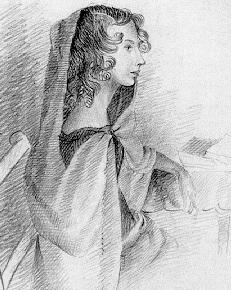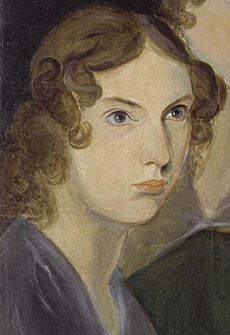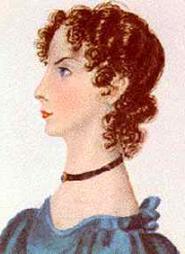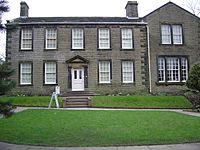Anne Brontë facts for kids
Quick facts for kids
Anne Brontë
|
|
|---|---|

A sketch of Anne Brontë by sister Charlotte, circa 1834
|
|
| Born | 17 January 1820 Thornton, West Riding of Yorkshire, England |
| Died | 28 May 1849 (aged 29) Scarborough, North Riding of Yorkshire, England |
| Resting place | St. Mary's Churchyard, Scarborough |
| Pen name | Acton Bell |
| Occupation | Poet, novelist, governess |
| Language | English |
| Nationality | English |
| Period | 1836–1849 |
| Genre | Fiction, poetry |
| Literary movement | Realism |
| Notable works | The Tenant of Wildfell Hall |
| Relatives | Brontë family |
| Signature | |
Anne Brontë (born January 17, 1820 – died May 28, 1849) was an English writer. She was a novelist and a poet. Anne was the youngest of the famous Brontë sisters, who were all well-known writers.
Anne's father, Patrick Brontë, was a clergyman. She lived most of her life with her family in Haworth, a village in Yorkshire, England. When she was 19, she started working as a governess, teaching children in their homes. This job lasted from 1839 to 1845.
After she stopped teaching, Anne focused on writing. She published a book of poems with her sisters, Charlotte and Emily, in 1846. This book was called Poems by Currer, Ellis, and Acton Bell. They all used male pen names to publish their work. Anne used the name Acton Bell.
Anne also wrote two novels. Her first novel, Agnes Grey, came out in 1847. It was based on her own experiences as a governess. Her second and last novel was The Tenant of Wildfell Hall, published in 1848. This book is seen as one of the first important feminist novels. It explored ideas about women's rights and independence.
Sadly, Anne's life ended early when she was only 29 years old. She died from a lung illness, likely tuberculosis. Even though her sister Charlotte later stopped her second novel from being reprinted for a while, Anne's books, like those of her sisters, are now considered classic works of English literature.
Contents
Anne Brontë's Family

Anne's father, Patrick Brontë (1777–1861), grew up in a small cottage in Ireland. He was the oldest of ten children from a family of farmers.
Her mother, Maria Branwell (1783–1821), came from a more well-off family in England. Her father was a successful grocer and tea merchant. Maria was the eleventh of twelve children.
Patrick and Maria married on December 29, 1812. Their first child, Maria (1814–1825), was born after they moved to Hartshead. In 1815, Patrick became a curate in Thornton. Their second daughter, Elizabeth (1815–1825), was born soon after. Four more children followed: Charlotte (1816–1855), Patrick Branwell (1817–1848), Emily (1818–1848), and finally Anne (1820–1849).
Learning and Imagination

Anne and her sisters and brother learned a lot at home. They had lessons in music and drawing. Anne, Emily, and Branwell even had piano lessons from the church organist in their town.
Reading was a big part of their lives and helped their imaginations grow. In 1826, their father gave Branwell a set of toy soldiers. This sparked their creativity even more. They gave the soldiers names and made up personalities for them, calling them the "Twelves."
This led to creating an imaginary world called "Angria." They drew maps and pictures for it. The children made up stories about the people in Angria and its main city, "Glass Town."
Over time, these fantasy worlds became very detailed. They had kings, armies, heroes, and even schools and publishers. The children wrote tiny books with very small writing to tell the stories of their characters and lands. This early writing practice helped them become amazing writers later on.
Teenage Years and School
Around 1831, when Anne was eleven, she and Emily started their own fantasy world called "Gondal." Anne and Emily were very close, especially after Charlotte went away to Roe Head School in 1831. Charlotte's friend, Ellen Nussey, visited Haworth in 1833 and said Emily and Anne were "like twins" and "inseparable."
When Charlotte came back from Roe Head, she taught Anne at home. Later, in 1835, Charlotte returned to Roe Head as a teacher, and Emily went with her as a student. Charlotte's teaching helped pay for Emily's schooling. But Emily found it hard to be away from home and became very homesick. She left school by October, and Anne took her place.
Anne was 15 when she first went away from home to Roe Head. She didn't make many friends there, but she was quiet and worked hard. She was determined to get an education so she could support herself. She stayed for two years, earning a good-conduct medal in 1836. She only came home for Christmas and summer holidays.
Working as a Governess
Anne found a second job as a governess for the children of Reverend Edmund Robinson and his wife, Lydia. This was at Thorp Green Hall, a comfortable country house near York. Anne worked there from 1840 to 1845. This house later appeared as "Horton Lodge" in her novel Agnes Grey.
Anne taught four children: Lydia (15), Elizabeth (13), Mary (12), and Edmund (8). At first, she found it difficult, similar to her first governess job. She missed her family and home. In a diary entry from 1841, she wrote that she didn't like her situation and wanted to leave.
However, Anne was determined. With more experience, she became very good at her job and was well-liked by the Robinsons. The Robinson girls even became her lifelong friends.
For the next five years, Anne spent most of her time at Thorp Green. She only visited her family for about five or six weeks a year during holidays. She also had to go with the Robinsons on their yearly trips to Scarborough. Between 1840 and 1844, Anne spent about five weeks each summer in this coastal town and loved it. Many places in Scarborough were used as settings in her novels, Agnes Grey and The Tenant of Wildfell Hall.
While working for the Robinsons, Anne and her sisters thought about opening their own school. They considered different places, but the plan never happened. Anne chose to return to Thorp Green. She did come home briefly in November 1842 when her aunt died. Her aunt, Elizabeth Branwell, left £350 (which was a lot of money back then) to each of her nieces.
Life Back at the Parsonage

Anne returned home in June 1846 and resigned from her governess position. She kept in touch with Elizabeth and Mary Robinson, exchanging letters. The Robinson sisters even visited Anne in December 1848.
Anne took her sister Emily to visit some of the places she had grown to love during her five years with the Robinsons. They planned to visit Scarborough, but that didn't work out. Instead, they went to York, where Anne showed Emily York Minster, a famous cathedral.
Anne Brontë's Death
Anne Brontë died peacefully on Monday, May 28, 1849, at about two o'clock in the afternoon. She was conscious and calm.
Her sister Charlotte decided that Anne should be buried in Scarborough, the place she loved. Anne was not buried in Haworth with the rest of her family. Her funeral was held on Wednesday, May 30. Anne's father could not make the 70-mile journey in time. The only other person at Anne's funeral was Miss Wooler, her former schoolmistress from Roe Head. Anne was buried in St Mary's churchyard, which is beneath the castle walls and overlooks the bay.
In 2011, the Brontë Society placed a new plaque at Anne Brontë's grave. The original gravestone had become hard to read because of weather. The new plaque, placed flat on the ground, explains the words on the old stone and corrects a small mistake about Anne's age. In April 2013, a special service was held at the gravesite to mark the new plaque.
See Also
The sisters of Anne Brontë:
The books of Anne Brontë:
- Poems by Currer, Ellis and Acton Bell (1846)
- Agnes Grey (1847)
- The Tenant of Wildfell Hall (1848)
Images for kids
-
A portrait by Branwell Brontë from about 1833. Some people think it's Emily, others think it's Anne.
See also
 In Spanish: Anne Brontë para niños
In Spanish: Anne Brontë para niños






